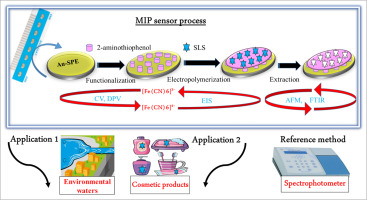当前位置:
X-MOL 学术
›
J. Electroanal. Chem.
›
论文详情
Our official English website, www.x-mol.net, welcomes your
feedback! (Note: you will need to create a separate account there.)
Development of a novel electrochemical sensor based on electropolymerized molecularly imprinted polymer for selective detection of sodium lauryl sulfate in environmental waters and cosmetic products
Journal of Electroanalytical Chemistry ( IF 4.1 ) Pub Date : 2018-08-01 , DOI: 10.1016/j.jelechem.2018.03.069 Soukaina Motia , Ioan Albert Tudor , L. Madalina Popescu , Roxana Mioara Piticescu , Benachir Bouchikhi , Nezha El Bari
Journal of Electroanalytical Chemistry ( IF 4.1 ) Pub Date : 2018-08-01 , DOI: 10.1016/j.jelechem.2018.03.069 Soukaina Motia , Ioan Albert Tudor , L. Madalina Popescu , Roxana Mioara Piticescu , Benachir Bouchikhi , Nezha El Bari

|
Abstract In this study, a novel molecularly imprinted polymer (MIP) sensor for the electrochemical detection of sodium lauryl sulfate (SLS) is reported. The MIP based screen-printed gold electrode (Au-SPE) was prepared by an electrochemical polymerization of 2-aminothiophenol (2-ATP) in the presence of SLS as target molecule. For control, a non-imprinted polymer (NIP) sensor was also constructed identically by omitting the SLS template. Moreover, the selectivity of the proposed MIP sensor was investigated by using analogues such as Ethylenediaminetetraacetic acid (EDTA), Tween 80 and Urea, revealing satisfactory selectivity toward SLS. The electrochemical characterization of the elaborated sensor was performed using cyclic voltammetry (CV), differential pulse voltammetry (DPV), and electrochemical impedance spectroscopy (EIS) techniques. The morphology of the MIP sensor was studied by means of Atomic Force Microscopy (AFM) and Fourier Transform Infrared Spectroscopy (FTIR) methods. Some experimental parameters such as number of cycle for the electropolymerization, incubation time of 2-ATP, elution and SLS incubation time, were optimized to improve the sensor performances. Under optimal conditions, the electrochemical sensor exhibits a logarithmic working range from 0.1 to 1000 pg/mL, and a detection limit of 0.18 pg/mL. Additionally, compared with reported works, the sensor possesses remarkable properties, such as a higher sensitivity and selectivity, a good reproducibility, a wider logarithmic range, a lower detection limit and a long-term stability. As real application, the developed MIP sensor was well employed to determine SLS contents in environmental waters and cosmetic products samples. A UV–vis spectrophotometer was used as reference method. A partial least squares (PLS) technique was well employed to study the correlation between the spectrophotometer and the MIP sensor technology with a satisfactory regression coefficient (R = 0.99). The obtained results during the sensor development and applications suggested an interesting and valuable tool for environmental analysis.
中文翻译:

基于电聚合分子印迹聚合物的新型电化学传感器的开发,用于选择性检测环境水和化妆品中的十二烷基硫酸钠
摘要 在这项研究中,报道了一种用于电化学检测月桂基硫酸钠 (SLS) 的新型分子印迹聚合物 (MIP) 传感器。基于 MIP 的丝网印刷金电极 (Au-SPE) 是在 SLS 作为目标分子存在下通过 2-氨基苯硫酚 (2-ATP) 的电化学聚合制备的。为了控制,还通过省略 SLS 模板同样构造了一个非印迹聚合物 (NIP) 传感器。此外,通过使用乙二胺四乙酸 (EDTA)、吐温 80 和尿素等类似物研究了所提出的 MIP 传感器的选择性,揭示了对 SLS 的令人满意的选择性。使用循环伏安法 (CV)、差分脉冲伏安法 (DPV) 和电化学阻抗谱 (EIS) 技术对精心制作的传感器进行电化学表征。通过原子力显微镜 (AFM) 和傅立叶变换红外光谱 (FTIR) 方法研究 MIP 传感器的形态。优化了一些实验参数,如电聚合循环数、2-ATP 的孵育时间、洗脱和 SLS 孵育时间,以提高传感器性能。在最佳条件下,电化学传感器的对数工作范围为 0.1 至 1000 pg/mL,检测限为 0.18 pg/mL。此外,与报道的工作相比,该传感器具有显着的特性,如更高的灵敏度和选择性、良好的重现性、更宽的对数范围、更低的检测限和长期稳定性。作为实际应用,开发的 MIP 传感器被很好地用于确定环境水和化妆品样品中的 SLS 含量。紫外-可见分光光度计用作参考方法。偏最小二乘法 (PLS) 技术被很好地用于研究分光光度计和 MIP 传感器技术之间的相关性,并具有令人满意的回归系数 (R = 0.99)。在传感器开发和应用过程中获得的结果为环境分析提供了一种有趣且有价值的工具。
更新日期:2018-08-01
中文翻译:

基于电聚合分子印迹聚合物的新型电化学传感器的开发,用于选择性检测环境水和化妆品中的十二烷基硫酸钠
摘要 在这项研究中,报道了一种用于电化学检测月桂基硫酸钠 (SLS) 的新型分子印迹聚合物 (MIP) 传感器。基于 MIP 的丝网印刷金电极 (Au-SPE) 是在 SLS 作为目标分子存在下通过 2-氨基苯硫酚 (2-ATP) 的电化学聚合制备的。为了控制,还通过省略 SLS 模板同样构造了一个非印迹聚合物 (NIP) 传感器。此外,通过使用乙二胺四乙酸 (EDTA)、吐温 80 和尿素等类似物研究了所提出的 MIP 传感器的选择性,揭示了对 SLS 的令人满意的选择性。使用循环伏安法 (CV)、差分脉冲伏安法 (DPV) 和电化学阻抗谱 (EIS) 技术对精心制作的传感器进行电化学表征。通过原子力显微镜 (AFM) 和傅立叶变换红外光谱 (FTIR) 方法研究 MIP 传感器的形态。优化了一些实验参数,如电聚合循环数、2-ATP 的孵育时间、洗脱和 SLS 孵育时间,以提高传感器性能。在最佳条件下,电化学传感器的对数工作范围为 0.1 至 1000 pg/mL,检测限为 0.18 pg/mL。此外,与报道的工作相比,该传感器具有显着的特性,如更高的灵敏度和选择性、良好的重现性、更宽的对数范围、更低的检测限和长期稳定性。作为实际应用,开发的 MIP 传感器被很好地用于确定环境水和化妆品样品中的 SLS 含量。紫外-可见分光光度计用作参考方法。偏最小二乘法 (PLS) 技术被很好地用于研究分光光度计和 MIP 传感器技术之间的相关性,并具有令人满意的回归系数 (R = 0.99)。在传感器开发和应用过程中获得的结果为环境分析提供了一种有趣且有价值的工具。











































 京公网安备 11010802027423号
京公网安备 11010802027423号